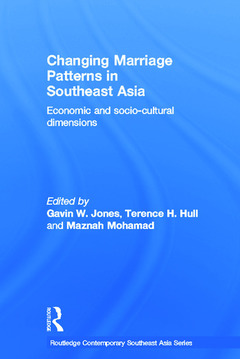Changing Marriage Patterns in Southeast Asia Economic and Socio-Cultural Dimensions Routledge Contemporary Southeast Asia Series
Coordonnateurs : Jones Gavin W., Hull Terence H., Mohamad Maznah

Various forms of partnering ? such as officially registered marriages, cohabiting relationships, and other kinds of relatively stable relationships - are crucial in the formation of families throughout the world. Although, today, forms of partnering in the region are not restricted to formal marriage, the norm remains for couples to marry ? to establish a new family, and to accept the cultural requirement to have children.
This book provides a comprehensive and up-to-date picture of partnerships and marriage in the Southeast Asian region using quantitative data alongside qualitative approaches.Through the research of demographers, sociologists and anthropologists, it examines the way trends in the formation and dissolution of marriages are related to changes in the region?s economy and society; illuminating both the broad forces affecting marriage patterns and the way these forces work out at the individual and family level.
Presenting the variety of contemporary marriage patterns in the region, with an emphasis on the ways in which marriage issues impinge on the welfare of those concerned, this book will be essential reading for students and scholars of Southeast Asia and the sociology of the family.
Part I. Overview 1. Marriage Trends in Insular Southeast Asia: Their Economic and Socio-Cultural Dimension 2. Statistical Indices of Marriage Patterns in Insular Southeast Asia 3. Teenage Marriage Trends and Issues in Insular Southeast Asia Part II. Indonesia 4. Regional Differences in Marriage Patterns in Indonesia in the Twenty-First Century 5. Politics and Marriage among Islamic Activists In Indonesia 6. Underage Marriage and Poverty in West Java, Indonesia 7. Delayed Marriage among Lower Socio-Economic Groups in an Indonesia Industrial City 8. Bugis Marriage: State Laws, Islam and Local Practice 9. Dowry Systems and Extended Family Networks: A Case Study In Manggarai and Nagekeo, Flores, Indonesia Part III. Malaysia 10. Understanding Marriage and Divorce Trends In Peninsular Malaysia 11. Marriage among the ‘Urbanized Rural Poor: Return Migrants In Northwest Kelantan 12. Gender Battles and the Syariah: Translating Islamic Marital Law into Everyday Practice in Malaysia 13. International Marriages in Malaysia: Issues arising from State Policies and Processes Part IV. Philippines And Singapore 14. Cohabitation and Poverty in the Philippines 15. The State Of Marriage In Singapore
Gavin W. Jones is Professor and the Research Leader for the Asia Research Institute at the National University of Singapore. He most recently co-edited Ultra-low Fertility in Pacific Asia: Trends, Causes and Policy Issues, also published by Routledge.
Terence H. Hull holds joint appointments with the Australian Demographic and Social Research Institute and the National Centre for Epidemiology and Population Health, at the Australian National University, where he is J.C. Caldwell chair.
Maznah Mohamad is currently Visiting Senior Research Fellow with the Asia Research Institute and the Department of Malay Studies at the National University of Singapore. Her previous publications include Feminism and the Women’s Movement in Malaysia and The Malay Handloom Weavers.
Date de parution : 09-2011
15.6x23.4 cm
Date de parution : 08-2015
15.6x23.4 cm
Thème de Changing Marriage Patterns in Southeast Asia :
Mots-clés :
Birth Control in China; Scharping; Social Policy in East and Southeast Asia; Ramesh; Population Decline and Ageing in Japan; Coulmas; O’Shaughnessy; Gender; State and Power in Contemporary Indonesia; Marriage and Divorce in Islamic Southeast Asia; Zaleha; Hassan; Cederroth; Managing Marital Disputes in Malaysia; Young Men; Islamic Southeast Asia; Gunung Kidul; Muslim World; Syariah Court; Spousal Age Gap; Changing Marriage Pattern; Pengadilan Agama; Archipelagic Southeast Asia; Teenage Marriage; Insular Southeast Asia; South Sulawesi; Johor Baru; NTT; Social Visit Pass; Tertiary Education; Islamic Family Law; Malay Mail; Bride Price; North Sulawesi; Matchmaking Process; Foreign Wives; Socio-economic Developments; Insular Southeast; Marriage Adaptation



